Activision Blizzard has turned in another better-than-expected quarter, beating its previous guidance handily. Activision CFO Dennis Durkin: “For the quarter, on a GAAP basis, we generated better-than-expected results, with revenues of $753 million and a loss per share of $0.03. On a non-GAAP basis for the quarter, we generated better-than-expected and record results, with revenues of $1.17 billion, including 43 percent from digital channels and record Q3 EPS of $0.23, $0.12 better than our previous guidance.”
The quarter was helped by Destiny‘s big sales, despite mixed critical reviews. Activision reports there are 9.5 million registered Destiny users, which pretty much sounds like there are at least 9.5 million copies in people’s hands. The rise in World of Warcraft subscribers, up by 600,000 in anticipation of the new expansion, also helped.
With all that, though, Electronic Arts still beat Activision for the quarter. EA’s GAAP Revenue was $990 million, with income of $3 million (1 cent per share); in non-GAAP terms, EA had net revenue of$1.22 billion, with income of $232 million (73 cents per share). Activision had GAAP net revenue of $753 million, showing a loss of $23 million (3 cents per share loss); its non-GAAP net revenue was $1.17 billion, with income of $260 million (23 cents per share, since Activision has more shares outstanding).
That wasn’t something Activision highlighted on its earnings call, as you might expect. The company did point with pride to the fact that now six major franchises are contributing to Activision’s results: World of Warcraft, Hearthstone, Diablo III, Destiny, Skylanders, and Call of Duty. That is two more major franchises than Activision had last year, which represents solid progress. Still, for a company of Activision’s size, it seems risky to have so few major contributors to the company’s revenue. Part of what is helping EA to move past Activision is EA’s more widespread contributions to revenue, including a large and varied mobile portfolio. While EA has certainly had some duds in the last few years, it’s had a good number of solid performers. That seems like a less risky strategy than depending on fewer titles, especially when some of Activision’s titles don’t necessarily have a bright future.
One of the issues for Activision is the future of the Call of Duty franchise, which has seen declining sales in the last several years. Some analysts have raised concerns that this year’s Call of Duty: Advanced Warfare may see total sales drop by 15 percent or more over last year’s Call of Duty: Ghosts, but Activision Publishing CEO Eric Hirshberg dismisses such concerns. “We expect that Advanced Warfare will go on to become the biggest game of the year, the most digitally purchased game in console history and the largest next-gen title in history and all of those by wide margins,” said Hirshberg.

That may or may not be the case, but it looks like Call of Duty has a bright future ahead in China, and that’s contributing very soon top Activision’s bottom line. “I shared in August that we had just entered large-scale beta testing with our partner Tencent [for Call of Duty Online in China],” said Hirshberg. “We have now successfully passed every development milestone, and we now plan to launch unlimited access beta testing in Q1 2015, which means the game will begin monetizing throughout China. Call of Duty Online is a major opportunity to expand our reach and build what may be our largest player community with year-round revenues.”
Activision clearly has high hopes for Call of Duty Online in China, which it would like to see generate Crossfire-like revenues — meaning close to $1 billion annually once it ramps up fully. That would be some healthy high-margin revenue. Could we see Call of Duty Online make its way to the US Possibly, though Activision certainly isn’t saying that now. With somewhere in the neighborhood of 20 million people willing to pay $60 for a disc-based version of Call of Duty, Activision’s not going to take a risk on that revenue stream any time soon. But that could change if disc-based sales were ever to decline substantially.
Meanwhile, Blizzard continues to forge ahead with the World of Warcraft expansion Warlords of Draenor will be a significant sales booster in the fourth quarter. It’s already helped by boosting subscriptions ahead of release. Those are not new players, though, for the most part. “So much of the resurgence comes from returning players, many of whom already have strong connections to the game,” said Blizzard CEO Mike Morhaime. In other words, World of Warcraft is not really appealing to new players at this point. It’s working to bring back old players for a short time with new expansions, though this effect usually lasts only a few months. It’s hard to see how World of Warcraft could appeal to a new audience, given how it’s substantially below its peak subscriber numbers and has been that way for years. Still, it looks to be a reliable profit engine for many years to come, even if it’s not poised for long-term growth.
Overall, Activision continues its transition to digital revenue, as with all traditional publishers. Most of that comes from subscriptions, DLC and virtual item sales, though full game downloads are making progress as well. Digital full game downloads “in the high teens” for Destiny and Diablo, according to Durkin.
Activision is poised to have a great fourth quarter, raising its guidance for the quarter and for the fiscal year (Activision, unlike most entertainment software companies, has a fiscal year that corresponds to the calendar year.) The company is looking for continued strength in its core franchises, and looking next year for two new major franchises to debut with Call of Duty Online and Blizzard’s MOBA Heroes of the Storm (though Blizzard doesn’t like to call it a MOBA). If Blizzard can generate the same sort of enthusiasm it’s garnered with Hearthstone, Heroes of the Storm could be a major revenue source. Even a fraction of the revenue generated by League of Legends (estimated to top $1 billion this year) would be a nice addition to Activision’s bottom line.
The bottom line is that Activision is performing well, keeping its major franchises profitable and moving forward while continuing efforts to add new franchises. There may not be any surprising acquisitions or big strategy shifts in the offing, but the company doesn’t seem to need that in order to continue growing and remaining profitable. It will be interesting to see if Electronic Arts’ more diverse strategy will put EA in the revenue lead, or if Activision’s slow and steady progress will win out in the end.

